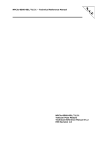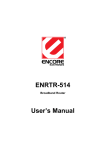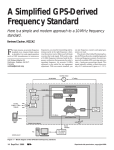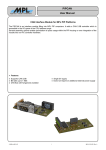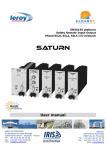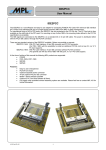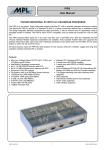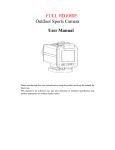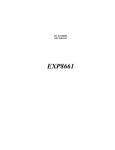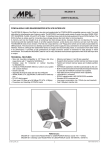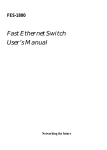Download Spiderlan User Manual
Transcript
SPIDERLAN USER MANUAL PC/104-PLUS 4 / 8 PORT FAST ETHERNET SWITCH MODULE The SPIDERLAN-family consists of universal high performance, compact and robust ethernet modules for the industrial use. SPIDERLAN unifies two complete 10/100BaseTX Fast Ethernet Adapters on a single PC/104-plus board. Each network controller is combined with a integrated 5 port layer-2 switch subsystem. So the board comes with up to eight (2x4) fully independent operating external 10/100BASE-TX ports, all available on RJ45 connectors. Switched networking minimizes network loading, eliminates collisions and enables true deterministic communications. SPIDERLAN is available as compact single PC/104-Plus module with connectors onboard, or with separated switch sub-modules for front panel assemblies. All these features make SPIDERLAN to the ideal solution for industrial network applications, like routers, firewalls, etc. Features · · · · · · · · · · · TM Up to 2 AMD PCNet Fast –III Fast Ethernet controllers on a single board High performance bus mastering for low CPU and bus utilisation. PCI specification 2.2 compliant 5 volt only power supply up to 2 integrated 5-port layer-2 ethernet switch subsystems up to 8 (2x4) external 10/100BaseTX ports onboard RJ45 connectors, or separated external switch sub-modules IEEE: 802.3u autonegotiation 10/100 Mbps, half/full duplex operation Full duplex IEEE: 802.3x support MDI / MDI-X autocrossover functionality 2 LED indicators for all ports Ó2002 by MPL AG 1 MEH-10095-001 Rev. B SPIDERLAN USER MANUAL TABLE OF CONTENTS 1. 1.1 1.2 1.3 1.4 2. INTRODUCTION ............................................................................................................................................. 4 ABOUT THIS MANUAL.............................................................................................................................. 4 SAFETY PRECAUTIONS AND HANDLING .............................................................................................. 4 ELECTROSTATIC DISCHARGE (ESD) PROTECTION ........................................................................... 4 EQUIPMENT SAFETY ............................................................................................................................... 4 GENERAL INFORMATION AND SPECIFICATIONS ..................................................................................... 5 2.1 SPECIFICATIONS...................................................................................................................................... 5 PHYSICAL/POWER........................................................................................................................................... 6 2.2 VERSION INFORMATION ......................................................................................................................... 6 2.3 DIMENSIONS............................................................................................................................................. 7 2.3.1 EXTERNAL SWITCH VERSION (SPIDERLAN-1E, SPIDERLAN-2E) ............................................. 7 2.3.1.1 BASEBOARD ................................................................................................................................ 7 2.3.1.2 SWITCH SUBMODULE (SPIMS4)................................................................................................ 8 2.3.2 ONBOARD SWITCH VERSION (SPIDERLAN-1P, SPIDERLAN-2P) .............................................. 9 3. PREPARATION FOR USE............................................................................................................................ 10 3.1 PARTS LOCATION .................................................................................................................................. 10 3.1.1 EXTERNAL SWITCH VERSION (SPIDERLAN-1E, SPIDERLAN-2E) ........................................... 10 3.1.1.1 BASEBOARD .............................................................................................................................. 10 3.1.1.2 SWITCH SUBMODULE (SPIMS4).............................................................................................. 11 3.1.1.3 ONBOARD SWITCH VERSION (SPIDERLAN-1P, SPIDERLAN-2P)........................................ 12 3.2 SWITCH SETTINGS ................................................................................................................................ 13 3.2.1 PC/104-PLUS SLOT SELECTOR SWITCH.................................................................................... 13 3.2.1.1 PC/104-PLUS MODULE STACK ................................................................................................ 13 3.2.1.2 SINGLE CHANNEL VERSION (SPIDERLAN-1P, SPIDERLAN-1E).......................................... 13 3.2.1.3 DUAL CHANNEL VERSION (SPIDERLAN-2P, SPIDERLAN-2E) ............................................. 13 3.3 CONNECTORS ........................................................................................................................................ 14 3.3.1 CONNECTOR FOR SPIMS-4 MODULE (SPIDERLAN-1E, SPIDERLAN-2E) ............................... 14 3.3.2 QUAD RJ45 – CONNECTORS ....................................................................................................... 15 3.3.3 PC/104 INTERFACE PIN NUMBERS ............................................................................................. 16 3.3.4 PC/104 PLUS INTERFACE PIN NUMBERS................................................................................... 17 4. OPERATION ................................................................................................................................................. 18 4.1 BLOCK DIAGRAM.................................................................................................................................... 18 4.1.1 ONBOARD SWITCH VERSION (SPIDERLAN-1P, SPIDERLAN-2P) ............................................ 18 4.1.2 EXTERNAL SWITCH VERSION (SPIDERLAN-1E, SPIDERLAN-2E) ........................................... 19 4.2 LED INDICATORS ................................................................................................................................... 20 4.2.1 INTEGRATED RJ45 CONNECTOR INDICATORS ........................................................................ 20 4.2.1.1 LINK / ACTIVITY (GREEN)......................................................................................................... 20 4.2.1.2 10/100 MBIT (YELLOW) ............................................................................................................. 20 4.2.2 EXTERNAL SWITCH VERSION (SPIDERLAN-1E, SPIDERLAN-2E) ........................................... 20 4.2.2.1 LED5 - TRANSMIT ACTIVITY .................................................................................................... 20 4.2.2.2 LED6 - RECEIVE ACTIVITY....................................................................................................... 20 4.3 5-PORT LAYER 2 SWITCH SUBSYSTEM.............................................................................................. 21 4.3.1 ADVANTAGES OF SWITCHED NETWORKING............................................................................ 21 4.3.2 ADDRESS LOOK UP ...................................................................................................................... 21 4.3.2.1 LEARNING .................................................................................................................................. 21 4.3.2.2 MIGRATION ................................................................................................................................ 21 4.3.2.3 AGING......................................................................................................................................... 21 4.3.2.4 FORWARDING ........................................................................................................................... 22 4.3.3 SWITCHING ENGINE ..................................................................................................................... 22 Ó 2002 by MPL AG 2 MEH-10095-001 Rev. B SPIDERLAN USER MANUAL 4.3.4 MAC OPERATION .......................................................................................................................... 22 4.3.4.1 INTER PACKET GAP (IPG)........................................................................................................ 22 4.3.4.2 BACKOFF ALGORITHM............................................................................................................. 22 4.3.4.3 LATE COLLISION ....................................................................................................................... 22 4.3.4.4 ILLEAGAL FRAMES ................................................................................................................... 22 4.3.4.5 FLOW CONTROL ....................................................................................................................... 23 4.3.4.6 HALF DUPLEX BACK PRESSURE ............................................................................................ 23 4.3.5 BROADCAST STORM PROTECTION ........................................................................................... 23 4.3.6 AUTO NEGOTIATION..................................................................................................................... 23 5. SOFTWARE .................................................................................................................................................. 24 5.1 DEVICE DRIVERS ................................................................................................................................... 24 5.1.1 LINKS TO THE LATEST DRIVERS ................................................................................................ 24 6. 6.1 6.2 SUPPORT INFORMATION ........................................................................................................................... 25 MPL AG .................................................................................................................................................... 25 PRODUCTION SERIAL AND REVISION NUMBER................................................................................ 25 Ó 2002 by MPL AG 3 MEH-10095-001 Rev. B SPIDERLAN USER MANUAL 1. INTRODUCTION 1.1 ABOUT THIS MANUAL This manual assists the installation and initialisation procedure by providing all the information necessary to handle and configure the SPIDERLAN. The manual is written for technical personnel responsible for integrating the SPIDERLAN into their system. 1.2 SAFETY PRECAUTIONS AND HANDLING For personal safety and safe operation of the SPIDERLAN, follow all safety procedures described here and in other sections of the manual. · Power must be removed from the system before installing (or removing) the SPIDERLAN to prevent the possibility of personal injury (electrical shock) and/or damage to the product. · Handle the product carefully, i.e., dropping or mishandling the SPIDERLAN can cause damage to assemblies and components. · Do not expose the equipment to moisture. WARNING There are no user-serviceable components on the SPIDERLAN 1.3 ELECTROSTATIC DISCHARGE (ESD) PROTECTION Various electrical components within the product are sensitive to static and electrostatic discharge (ESD). Even a non-sensible static discharge can be sufficient to destroy or degrade a component's operation! With an open housing, do not touch any electronic components. Handle or touch only the unit chassis. 1.4 EQUIPMENT SAFETY Great care is taken by MPL that all its products are thoroughly and rigorously tested before leaving the factory to ensure that they are fully operational and conform to specification. However, no matter how reliable a product, there is always the remote possibility that a defect may occur. The occurrence of a defect on this device may, under certain conditions, cause a defect to occur in adjoining and/or connected equipment. It is the user’s responsibility to ensure that adequate protection for such equipment is incorporated when installing this device. MPL accepts no responsibility whatsoever for such kind of defects, however caused. Ó 2002 by MPL AG 4 MEH-10095-001 Rev. B SPIDERLAN USER MANUAL 2. GENERAL INFORMATION AND SPECIFICATIONS This chapter provides a general overview over the SPIDERLAN and its features. It outlines the electrical and physical specifications of the product, its power requirements and a list of related publications. 2.1 SPECIFICATIONS ELECTRICAL Ethernet Controller: TM · single/dual AMD PCNet FAST III ethernet controllers · 32-bit PCI bus master · supports 3.3V and 5V PCI signalling · DMA buffer management unit for low CPU and bus utilisation · Large independent RX/TX FIFO buffers · IEEE802.3 and Blue book ethernet compatible · Device drivers for all major operation systems available Ethernet Switch: · single/dual Kendin KS8995E layer-2 ethernet switch chipset · 1 internal port, (connected to onboard ethernet controller) · 4 external 10/100BaseTX ports · 128 kB SRAM for frame buffering · 1.4Gps high performance memory bandwidth · Lookup engine supports 1k absolute MAC addresses · Automatic address learning, aging and migration · Broadcast storm protection Physical: · Hardware based 10/100, full/half, flow control and autonegotiation · Full duplex IEEE802.3x flow control · Half duplex back pressure flow control Connectors: · single/dual onboard quad-RJ45 connectors or optionally 40 pin mini headers for the connection of external switch sub-modules Indicators: · indicators for link status / activity and 10/100 Mbps operation (for each port) Ó 2002 by MPL AG 5 MEH-10095-001 Rev. B SPIDERLAN USER MANUAL PHYSICAL/POWER Form factor: Length x width x height : 95.89 mm (3.775’’) x 90.17 mm (3.550’’) x 13.5 mm max. (please refer to section 2.2) Weight: 120g / 0.265lbs (fully equipped SPIDERLAN-2P) Input Power : +5VDC +- 5% Power consumption: Typ. 2.5W (single controller, 4ports) / 5W (dual controller, 8 ports) ENVIRONMENT Temperature range: 0°C to +70°C (+32°F to +158°F) optional -40°C to +75°C (-40°F to +185°F) Relative humidity: 10% ... 90% non condensing 2.2 VERSION INFORMATION SPIDERLAN-1P: SPIDERLAN-2P: SPIDERLAN-1E: SPIDERLAN-2E: Ó 2002 by MPL AG single ethernet controller with onboard switch subsystem, dual ethernet controllers, each with onboard switch subsystem single ethernet controller with separated switch sub-module dual ethernet controllers with two separated switch sub-modules 6 MEH-10095-001 Rev. B SPIDERLAN USER MANUAL 2.3 DIMENSIONS 2.3.1 EXTERNAL SWITCH VERSION (SPIDERLAN-1E, SPIDERLAN-2E) 11.12 2.3.1.1 BASEBOARD + 7.62 11.12 85.09 81.28 90.17 1 2 O N + 5.08 5.08 34.25 38.99 46.10 53.21 59.75 60.33 90.81 Ó 2002 by MPL AG 10.64 10.60 9.35 6.00 11.45 95.89 7 MEH-10095-001 Rev. B SPIDERLAN USER MANUAL 2.3.1.2 SWITCH SUBMODULE (SPIMS4) 4.34 4.60 24.38 29.85 4.34 1.60 2.50 13.49 + 25.78 30.19 45.16 70.66 88.41 92.84 96.52 Ó 2002 by MPL AG 8 MEH-10095-001 Rev. B SPIDERLAN USER MANUAL 2.3.2 ONBOARD SWITCH VERSION (SPIDERLAN-1P, SPIDERLAN-2P) + 90.17 85.09 81.28 7.62 5.08 1 2 O N + + Ó 2002 by MPL AG 9 10.64 1.60 3.40 10.60 9.35 11.45 13.49 5.08 22.63 80.85 90.81 95.89 MEH-10095-001 Rev. B SPIDERLAN USER MANUAL 3. PREPARATION FOR USE 3.1 PARTS LOCATION 3.1.1 EXTERNAL SWITCH VERSION (SPIDERLAN-1E, SPIDERLAN-2E) 3.1.1.1 BASEBOARD PC/104 connector PC/104-Plus connector LED6 LED5 Channel 2 LED6 LED5 AB 1 39 40 1 2 ABCD 1 SPIMS4 submodule connector DC 0 + PC/104 connector PC/104-Plus connector 1 2 O N + PC/104-Plus Slot Selector Switch 2 1 40 39 30 32 SPIMS4 submodule connector LED5 LED6 PC/104 connector Channel 1 PC/104-Plus connector LED5 LED6 Ó 2002 by MPL AG 10 MEH-10095-001 Rev. B SPIDERLAN USER MANUAL 3.1.1.2 SWITCH SUBMODULE (SPIMS4) LED1-2 LED1-1 LED2-2 LED2-1 LED3-2 LED3-1 LED4-2 LED4-1 + 8 1 8 Port 1 1 8 Port 2 1 8 Port 3 1 Port 4 4x 10/100BaseTX, RJ45 2 1 40 39 SPIMS4 submodule connector Ó 2002 by MPL AG 11 MEH-10095-001 Rev. B SPIDERLAN USER MANUAL 3.1.1.3 ONBOARD SWITCH VERSION (SPIDERLAN-1P, SPIDERLAN-2P) LED1-2 PC/104-Plus connector LED1-1 LED2-2 LED2-1 LED3-2 LED3-1 LED4-2 LED4-1 PC/104 connector + 8 1 8 Port 1 1 8 Port 2 1 8 Port 3 1 Port 4 Channel 2 AB 1 4x 10/100BaseTX, RJ45 factory used 1 ABCD DC PC/104 connector 0 PC/104-Plus connector + + 1 2 O N PC/104-Plus Slot Selector Switch 30 4x 10/100BaseTX, RJ45 32 Channel 1 PC/104 connector LED1-2 LED1-1 LED2-2 LED2-1 LED3-2 LED3-1 LED4-2 LED4-1 PC/104-Plus connector + 8 1 8 Port 1 Ó 2002 by MPL AG 1 8 Port 2 1 8 Port 3 12 1 Port 4 MEH-10095-001 Rev. B SPIDERLAN USER MANUAL O N 3.2 SWITCH SETTINGS 1 2 Default switch settings are in brackets. 3.2.1 PC/104-PLUS SLOT SELECTOR SWITCH 3.2.1.1 PC/104-PLUS MODULE STACK Module Slot 4 Module Slot 3 Module Slot 2 Module Slot 1 Baseboard 3.2.1.2 SINGLE CHANNEL VERSION (SPIDERLAN-1P, SPIDERLAN-1E) SW1-1 (OFF) OFF ON ON SW1-2 (OFF) ON OFF ON Ethernet Controller 1 Module Slot 1 Module Slot 2 Module Slot 3 Module Slot 4 3.2.1.3 DUAL CHANNEL VERSION (SPIDERLAN-2P, SPIDERLAN-2E) SPIDERLAN versions, which have 2 network controllers, behave like 2 independent PC-104-plus cards. Two module slots in the PC-104-plus stack will be occupied. SW1-1 (OFF) OFF ON ON Ó 2002 by MPL AG SW1-2 (OFF) ON OFF ON Ethernet Controller 1 Module Slot 1 Module Slot 2 Module Slot 3 Module Slot 4 13 Ethernet Controller 2 Module Slot 2 Module Slot 3 Disabled Disabled MEH-10095-001 Rev. B SPIDERLAN USER MANUAL 3.3 CONNECTORS 3.3.1 CONNECTOR FOR SPIMS-4 MODULE (SPIDERLAN-1E, SPIDERLAN-2E) Pin number 1 2 3 4 5 6 7 8 9 10 11 12 13 14 15 16 17 18 19 20 21 22 23 24 25 26 27 28 29 30 31 32 33 34 35 36 37 38 39 40 Ó 2002 by MPL AG Signal VCC VCC MDIO GND MDC GND RXD3 GND RXD2 GND RXD1 GND RXD0 GND RXDV GND RXCLK GND RXER GND TXER GND TXCLK GND TXEN GND TXD0 GND TXD1 GND TXD2 GND TXD3 GND COL GND CRS GND VCC VCC Description +3.3V +3.3V Management Data Input/Output Ground Management Data Clock Ground Receive Data, Bit 3 Ground Receive Data, Bit 2 Ground Receive Data, Bit 1 Ground Receive Data, Bit 0 Ground Receive Data Valid Ground Receive Clock Ground Receive Error Ground Transmit Coding Error Ground Transmit Clock Ground Transmit Enable Ground Transmit Data, Bit 0 Ground Transmit Data, Bit 1 Ground Transmit Data, Bit 2 Ground Transmit Data, Bit 3 Ground Collision Detected Ground Carrier Sense Ground +3.3V +3.3V 14 Pinout 40 39 2 1 Figure 3.6 MEH-10095-001 Rev. B SPIDERLAN USER MANUAL 3.3.2 QUAD RJ45 – CONNECTORS Port 1 Pin number 1 2 3 4 5 6 7 8 Signal RX1+ RX1TX1+ Pin number 1 2 3 4 5 6 7 8 Signal RX2+ RX2TX2+ Pinout Description Receive data + Receive data Transmit data + CMT 75 Ohm, common mode termination TX1- Transmit data - CMT 75 Ohm, common mode termination Port 2 Description Receive data + Receive data Transmit data + CMT 75 Ohm, common mode termination TX2- Transmit data - CMT 75 Ohm, common mode termination + 8 1 8 1 8 1 8 4 port RJ45 connector Port 3 Pin number 1 2 3 4 5 6 7 8 Signal RX3+ RX3TX3+ Pin number 1 2 3 4 5 6 7 8 Signal RX4+ RX4TX4+ Description Receive data + Receive data Transmit data + CMT 75 Ohm, common mode termination TX3- Transmit data - CMT 75 Ohm, common mode termination Figure 3.10 Port 4 Ó 2002 by MPL AG Description Receive data + Receive data Transmit data + CMT 75 Ohm, common mode termination TX4- Transmit data - CMT 75 Ohm, common mode termination 15 MEH-10095-001 Rev. B 1 SPIDERLAN USER MANUAL 3.3.3 PC/104 INTERFACE PIN NUMBERS Number 0 1 2 3 4 5 6 7 8 9 10 11 12 13 14 15 16 17 18 19 20 21 22 23 24 25 26 27 28 29 30 31 32 Notes: *1 *2 Row A -/IOCHCK SD7 SD6 SD5 SD4 SD3 SD2 SD1 SD0 IOCHRDY AEN SA19 SA18 SA17 SA16 SA15 SA14 SA13 SA12 SA11 SA10 SA9 SA8 SA7 SA6 SA5 SA4 SA3 SA2 SA1 SA0 GND Row B -GND RSTDRV +5V IRQ9 -5V DRQ2 -12V /ENDXFR +12V NC /SMEMW /SMEMR /IOW /IOR /DACK3 DRQ3 /DACK1 DRQ1 /REFRESH SYSCLK IRQ7 IRQ6 IRQ5 IRQ4 IRQ3 /DACK2 TC BALE +5V OSC GND GND Row C GND /SBHE LA23 LA22 LA21 LA20 LA19 LA18 LA17 /MEMR /MEMW SD8 SD9 SD10 SD11 SD12 SD13 SD14 SD15 NC -------------- Row D GND /MEMCS16 /IOCS16 IRQ10 IRQ11 IRQ12 IRQ15 IRQ14 /DACK0 DRQ0 /DACK5 DRQ5 /DACK6 DRQ6 /DACK7 DRQ7 +5V /MASTER GND GND -------------- Pinout AB 0 1 DC 19 32 Signal not used or not available. For more detailed information refer to the PC/104 Specification, Version 2.3 and to the IEEE P996 draft standard (D2.02). Ó 2002 by MPL AG 16 MEH-10095-001 Rev. B SPIDERLAN USER MANUAL 3.3.4 PC/104 PLUS INTERFACE PIN NUMBERS Number 1 2 3 4 5 6 7 8 9 10 11 12 13 14 15 16 17 18 19 20 21 22 23 24 25 26 27 28 29 30 Notes: *1 *2 Row A GND +5V AD5 C/BE0 GND AD11 AD14 +3,3V SERR GND STOP +3,3V FRAME GND AD18 AD21 +3,3V IDSEL0 AD24 GND AD29 +5V REQ0 GND GNT1 +5V CLK2 GND +12V -12V Row B NC AD2 GND AD7 AD9 +5V AD13 C/BE1 GND PERR +3,3V TRDY GND AD16 +3,3V AD20 AD23 GND C/BE3 AD26 +5V AD30 GND REQ2 +5V CLK0 +5V INTD INTA NC Row C +5V AD1 AD4 GND AD8 AD10 GND AD15 (SBO)*1 +3,3V LOCK GND IRDY +3,3V AD17 GND AD22 IDSEL1 +5V AD25 AD28 GND REQ1 +5V GNT2 GND CLK3 +5V INTB NC Row D AD0 +5V AD3 AD6 GND M66EN AD12 +3,3V PAR SDONE GND DEVSEL +3,3V C/BE2 GND AD19 +3,3V IDSEL2 IDSEL3 GND AD27 AD31 +5V GNT0 GND CLK1 GND RST INTC GND Pinout ABCD 1 30 Signal not available (designed for the use of max. 2 modules). For more detailed information refer to the PC/104 – Plus Specification, Version 1.0 and to the PCI Specification Rev.2.1. Ó 2002 by MPL AG 17 MEH-10095-001 Rev. B RJ45 + 2x LED RJ45 + 2x LED RJ45 + 2x LED RJ45 + 2x LED Port 3 Magnetics Magnetics Magnetics Magnetics Port 4 Port 2 Magnetics Magnetics Port 4 Port 1 Magnetics Magnetics Port 3 Port 2 Magnetics Magnetics Magnetics Magnetics Port 1 Magnetics Magnetics Magnetics Magnetics RJ45 + 2x LED RJ45 + 2x LED 18 RJ45 + 2x LED Ethernet Switch 2 Ethernet Switch 2 KS8995E KS8995E Ethernet Switch 1 Ethernet Switch 1 KS8995E KS8995E Port 5 Port 5 Ethernet Controller 1 TM Ethernet Controller 1 III AMD PCNet - FAST TM AMD PCNet - FAST III (AM79C973) (AM79C973) Ethernet Controller 2 TM - FAST Ethernet Controller 2 III AMD PCNet TM AMD PCNet - FAST III (AM79C973) (AM79C973) Channel 2 Channel 1 PC/104 Plus PC/104 Plus Slot Selector Slot Selector PC/104 Plus PC/104 Plus Slot Selector Slot Selector PC/104 Plus Stack Through Connector PCI BUS Ó 2002 by MPL AG RJ45 + 2x LED PC/104 Plus Stack Trough Connector PC/104 Stack Through Connector PC/104 Stack Through Connector SPIDERLAN USER MANUAL 4. OPERATION 4.1 BLOCK DIAGRAM 4.1.1 ONBOARD SWITCH VERSION (SPIDERLAN-1P, SPIDERLAN-2P) MEH-10095-001 Rev. B RJ45 + 2x LED RJ45 + 2x LED RJ45 + 2x LED RJ45 + 2x LED RJ45 + 2x LED RJ45 + 2x LED RJ45 + 2x LED 19 RJ45 + 2x LED Magnetics Magnetics Port 4 Port 3 Port 2 Magnetics Magnetics Magnetics Magnetics Port 1 Port 4 Magnetics Magnetics Magnetics Magnetics Port 3 Port 2 Magnetics Magnetics Magnetics Magnetics Port 1 Magnetics Magnetics Ethernet Switch 2 Ethernet Switch 2 KS8995E KS8995E Ethernet Switch 1 Ethernet Switch 1 KS8995E KS8995E 40 pin mini header Port 5 SPIMS4 Port 5 ribbon cable ribbon cable 40 pin mini header 40 pin mini header SPIMS4 Ethernet Controller 2 TM Ethernet Controller 2 III AMD PCNet - FAST TM AMD PCNet - FAST III (AM79C973) (AM79C973) Channel 2 Ethernet Controller 1 TM Ethernet Controller 1 III AMD PCNet - FAST TM AMD PCNet - FAST III (AM79C973) (AM79C973) Channel 1 PC/104 Plus PC/104 Plus Slot Selector Slot Selector PC/104 Plus PC/104 Plus Slot Selector Slot Selector PC/104 Plus Stack Through Connector PCI BUS Ó 2002 by MPL AG 40 pin mini header PC/104 Plus Stack Trough Connector PC/104 Stack Through Connector PC/104 Stack Through Connector SPIDERLAN USER MANUAL 4.1.2 EXTERNAL SWITCH VERSION (SPIDERLAN-1E, SPIDERLAN-2E) MEH-10095-001 Rev. B SPIDERLAN USER MANUAL 4.2 LED INDICATORS 4.2.1 INTEGRATED RJ45 CONNECTOR INDICATORS 4.2.1.1 LINK / ACTIVITY (GREEN) On = Link Pass Off = Link Failed, Transmit / Receive Activity Please refer to section 3.1, port 1:LED1-1, port 2: LED2-1, port 3: LED3-1, port 4: LED4-1 4.2.1.2 10/100 MBIT (YELLOW) On = 100MBit Off = 10MBit Please refer to section 3.1, port 1:LED1-2, port 2: LED2-2, port 3: LED3-2, port 4: LED4-2 4.2.2 EXTERNAL SWITCH VERSION (SPIDERLAN-1E, SPIDERLAN-2E) 4.2.2.1 LED5 - TRANSMIT ACTIVITY This LED indicate transmit activity of the network controller. (data transmission to a cable connected external switch submodule (SPIMS4)). For the location of the LED please refer to section 3.1.1.1. On = Receive Activity Off = No Activity 4.2.2.2 LED6 - RECEIVE ACTIVITY This LED indicate receive activity of the network controller. (data reception from a cable connected external switch submodule (SPIMS4)) For the location of the LED please refer to section 3.1.1.1. On = Transmit Activity Off = No Activity Ó 2002 by MPL AG 20 MEH-10095-001 Rev. B SPIDERLAN USER MANUAL 4.3 5-PORT LAYER 2 SWITCH SUBSYSTEM Each of the SPIDERLAN NIC channels can be equipped with complete 5 port switch subsystem. 1 Port is connected to onboard NIC and 4 ports are available on RJ45 connectors. 4.3.1 ADVANTAGES OF SWITCHED NETWORKING Unlike hubs, switches operate at the data link layer (layer 2) of the OSI reference model. Each packet which is received, will be examined and processed, rather then simply repeated. The MAC addresses of the nodes residing on each network segment are mapped and only the necessary traffic is allowed to pass through the switch. Additionally, bad or misaligned packets are prevented from spreading by not forwarding them. Packet filtering and regeneration enables to split the network into separate collision domains. In switched networks, each segment is an independent collision domain. This allows greater distances, more nodes and lowers the overall collision rates. Another advantage is that the ports can work with different data rates (10 or 100Mbit) or with half /full duplex. 4.3.2 ADDRESS LOOK UP The switch controller provides a look up engine with a internal look up table, that stores MAC addresses and their associated information. It contains 1K full CAM with 48-bit address plus switching information. It is guaranteed to learn 1K addresses and distinguishes itself from hash-based look up tables which, depending on the operating environment and probabilities, may not guarantee the absolute number of addresses it can learn. 4.3.2.1 LEARNING The look up engine will update its table with a new entry if the following conditions are met: (1) The received packet's source MAC address (SA) does not exist in the look up table. (2) The received packet is good; the packet has no receiving errors, and is of legal length. The look up engine will insert the qualified source MAC address (SA) into the table, along with the port number, time stamp. If the table is full, the last entry of the table will be deleted first to make room for the new entry. 4.3.2.2 MIGRATION The look up engine also monitors whether a station is moved. If it happens, it will update the table accordingly. Migration happens when the following conditions are met: (1) The received packet's source MAC address (SA) is in the table but the associated source port information is different. (2) The received packet is good; the packet has no receiving errors, and is of legal length. The look up engine will update the existing record in the table with the new source port information. 4.3.2.3 AGING Aging is the amount of time the switch waits until it removes a source MAC address (SA) from the look up table due the fact that the source address has not initiated a transmission within the aging time, The look up engine will update the time stamp information of a record whenever the corresponding source MAC address (SA) appears. The time stamp is used in the aging process. If a record is not updated for a period of time, the look up engine will then remove the record from the table. The look up engine constantly performs the aging process and will continuously remove aging records. The aging period is set to 300 seconds. Ó 2002 by MPL AG 21 MEH-10095-001 Rev. B SPIDERLAN USER MANUAL 4.3.2.4 FORWARDING The packets will be forwarded as follows: (1) If the destination MAC address (DA) look up results is a "match", the destination port information will be used to determine where the packet goes. (2) If the destination MAC address (DA) look up result is a "miss", the packet will be forwarded to all other ports except the port that received the packet. (3) All the multicast and broadcast packets will be forwarded to all other ports except the source port. The following packets will not be forwarded: (1) Error packets. These include framing errors, FCS errors, alignment errors, and illegal size packet errors. (2) 802.3x pause frames. These packets will be intercepted and do the appropriate actions. (3) "Local" packets. Based on destination address (DA) look up. If thedestination port from the look up table matches the port where the packet wasfrom, the packet is defined as "local". 4.3.3 SWITCHING ENGINE A very high performance switching engine moves the data to and from the MAC’s and packet buffers. It operates in store and forward mode, while the efficient switching mechanism reduces overall latency. It has in internal buffer for frames that is 32Kx32 (128KB). This resource is shared between the five ports. Each buffer is sized at 128Bytes and therefore there are a total of 1024 buffers available. A per port maximum is set to 205 buffers per port. 4.3.4 MAC OPERATION The switch controller strictly abides by IEEE 802.3 standard to maximize compatibility. 4.3.4.1 INTER PACKET GAP (IPG). If a frame is successfully transmitted, the 96 bit time IPG is measured between the two consecutive TXEN. If the current packet is experiencing collision, the 96 bit time IPG is measured from CRS and the next TXEN. 4.3.4.2 BACKOFF ALGORITHM The switch controller implements the IEEE Std 802.3 binary exponential back-off algorithm and "aggressive mode" back off. 4.3.4.3 LATE COLLISION If a transmit packet experiences collisions after 512 bit times of the transmission, the packet will be dropped. 4.3.4.4 ILLEAGAL FRAMES Illegal size frames will be discarded, as defined by the IEEE Std 802.3u, including short frames (less than 64 bytes), long frames (greater than 1522 bytes), and FCS error frames. VLAN tagged frames are treated as regular frames and any VLAN related functions will not performed. The switch should be treated as a single VLAN domain. VLAN frames will be dropped, if the size is larger than 1522 bytes and non-VLAN frames, if the size is larger than 1518 bytes. Ó 2002 by MPL AG 22 MEH-10095-001 Rev. B SPIDERLAN USER MANUAL 4.3.4.5 FLOW CONTROL Standard 802.3x flow control frames on both, transmit and receive sides, are supported. On the receive side, if a pause control frame is received, the next normal frame will not be transmitted, until the timer, specified in the pause control frame, expires. If another pause frame is received before the current timer expires, the timer will be updated with the new value in the second pause frame. During this period (being flow controlled), only flow control packets from the switch controller will be transmitted. On the transmit side, the switch controller has intelligent and efficient ways to determine when to invoke flow control. The flow control is based on availability of the system resources, including available buffers, available transmit queues and available receive queues. A port, which just received a packet, will be flow controlled, if the destination port resource is being used up. A flow control frame (XOFF), will be issued, containing the maximum pause time defined in IEEE standard 802.3x. Once the resource is freed up, the other flow control frame (XON) with zero pause time will be send out, to turn off the flow control (turn on transmission to the port). A hysterisis feature is provided to prevent flow control mechanism from being activated and deactivated too many times. All ports will flow controlled, if the receive queue becomes full. 4.3.4.6 HALF DUPLEX BACK PRESSURE Half duplex back pressure (Note: not in 802.3 standards) is also provided. The activation and deactivation conditions are the same as the above in full duplex mode. If back pressure is required, the switch controller will send preambles to defer other stations transmission (carrier sense deference). To avoid jabber and excessive deference defined in 802.3 standard, after a certain time it will discontinue the carrier sense but it will raise the carrier sense quickly. This short silent time (no carrier sense) is to prevent other stations from sending out packets and keeps other stations in carrier sense deferred state. If the port has packets to send during a back pressure situation, the carrier sense type back pressure will be interrupted and those packets will be transmitted instead. If there are no more packets to send, carrier sense type back pressure will be active again until switch resources free up. If a collision occurs, the binary exponential back-off algorithm is skipped and carrier sense is generated immediately, reducing the chance of further colliding and maintaining carrier sense to prevent reception of packets. This scheme is better than collision based back pressure. The switch controller also supports collision based flow control. If the destination port is congested, the incoming packets will be collided to achieve back pressure. 4.3.5 BROADCAST STORM PROTECTION The switch controller has an intelligent way to protect the switch system from receiving too many broadcast packets. Broadcast packets will be forwarded to all ports, except the source port, and thus will use too many switch resources (bandwidth and available space in transmit queues). Broadcast or multicast packets will be discarded, if the number of those packets exceeds 25% of the network line rate in preset period of time. If the preset period expires, it will then resume receiving broadcast or multicast packets until the threshold is reached. 4.3.6 AUTO NEGOTIATION All ports conforms to the auto negotiation protocol as described by the 802.3 committee. Auto negotiation allows UTP (Unshielded Twisted Pair) link partners to select the best common mode of operation. In auto negotiation the link partners advertise capabilities across the link to each other. If auto negotiation is not supported or the link partner is forced to bypass auto negotiation, then the mode is set by observing the signal at the receiver. This is known as parallel mode because while the transmitter is sending auto negotiation advertisements, the receiver is listening for advertisements or a fixed signal protocol. The flow for the link set up is depicted below. Ó 2002 by MPL AG 23 MEH-10095-001 Rev. B SPIDERLAN USER MANUAL 5. SOFTWARE 5.1 DEVICE DRIVERS Drivers for different operating systems are available. 5.1.1 LINKS TO THE LATEST DRIVERS The latest driver versions are also available on the internet. · AMD Connectivity Solutions, Networking PCNet Family device drivers, http://www.amd.com Note: Links may have been changed in the meantime. The latest links can also be found on the MPL homepage http://www.mpl.ch/ Ó 2002 by MPL AG 24 MEH-10095-001 Rev. B SPIDERLAN USER MANUAL 6. SUPPORT INFORMATION 6.1 MPL AG In case of questions contact MPL AG or your local distributor. MPL AG homepage: Email address: www.mpl.ch [email protected] 6.2 PRODUCTION SERIAL AND REVISION NUMBER To get the actual production revision number of your device, please see the label on the bottom of the SPIDERLAN : housing. SPIDERLAN S/N: 1000 [A] Production Serial Number Ó 2002 by MPL AG Production Revision Number 25 MEH-10095-001 Rev. B SPIDERLAN USER MANUAL This page is intentionally left blank. Ó 2002 by MPL AG 26 MEH-10095-001 Rev. B SPIDERLAN USER MANUAL This page is intentionally left blank. Ó 2002 by MPL AG 27 MEH-10095-001 Rev. B SPIDERLAN USER MANUAL COPYRIGHT AND REVISION HISTORY Copyright Ó 2002 by MPL AG Elektronikunternehmen. All rights reserved. Reproduction of this document in part or whole, by any means is prohibited, without written permission from MPL AG Elektronikunternehmen. This manual reflects Revision A of the SPIDERLAN. DISCLAIMER The information contained herein is believed to be accurate as of the date of this publication, however, MPL AG will not be liable for any damages, including indirect or consequential, arising out of the application or use of any product, circuit or software described herein. MPL AG reserves the right to make changes to any product herein to improve reliability, function or design. TRADEMARKS Brand or product names are trademarks and registered trademarks of their respective holders. Our local distributor: Ó 2002 by MPL AG 28 MEH-10095-001 Rev. B




























